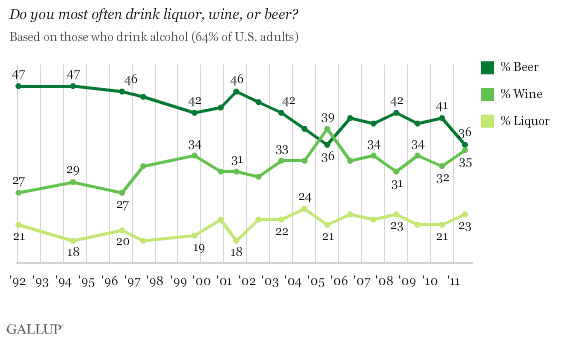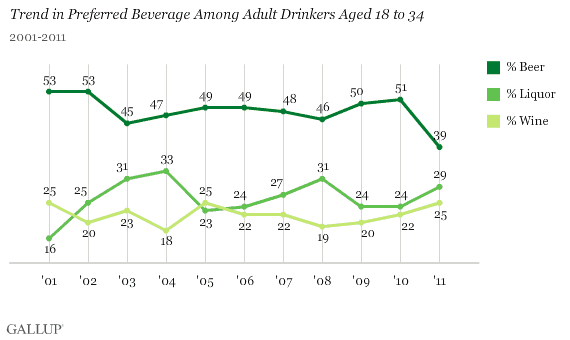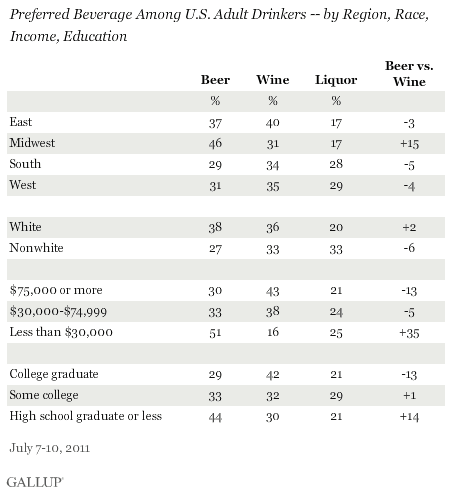PRINCETON, NJ -- For only the second time in two decades, wine ties beer as the top choice when U.S. drinkers are asked whether they most often drink liquor, wine, or beer. Gallup now finds nearly as many U.S. drinkers naming wine (35%) as beer (36%), while liquor still registers a distant third at 23%.

The 36% of U.S. drinkers favoring beer in Gallup's July 7-10 poll ties for the lowest Gallup has recorded for the popular beverage since initiating this measure in 1992. The other low reading came in 2005, at the same time Americans' preference for wine temporarily surged to 39%. Beer regained a solid lead at the top spot, until this year.
The 35% now favoring wine and 23% liquor are near the record highs for these beverages, although preferences have generally fluctuated around the current levels since about 2003.
Preference for beer declined among all age groups this year, but it fell the most among young adults -- dropping to 39% today from 51% in 2010. By contrast, middle-aged adults' preference for beer fell just three percentage points (to 41% from 44%), and older adults' fell two points (to 27% from 29%).
Younger adults' decreased preference for beer is accompanied by slight increases in their preferences for liquor and wine. Additionally, 2% of young adults this year volunteered that they most often drink cordials, up from less than 1% in 2010 and in most prior years.

Men, Young Adults, Midwesterners Exhibit Strongest Beer Preference
Gallup continues to document strong demographic differences in drink preferences, particularly along gender, age and socio-economic lines.
Nearly half of male drinkers, 48%, say they most often drink beer, followed by liquor at 26%, while 51% of female drinkers prefer wine. This pattern is consistent with prior years, although the preference for beer is down slightly among both groups compared with 2010.
Older adults tend to prefer wine, while -- despite the recent decline among young adults -- the plurality of younger and middle-aged adults favor beer.
As a result of these distinctions by age and gender, there are extremely sharp differences in drink preferences between younger men and older women, with most of the former preferring beer, and the latter, wine. Older men and younger women have somewhat more varied preferences.

Geographically, beer enjoys its greatest popularity in the Midwest, while wine does best in the East and liquor in the South and West. Adults with no college education and those in lower-income households are also much more likely to favor beer. Nonwhites are more likely than whites to favor liquor.

Bottom Line
The predominance of beer as Americans' favorite drink has waned over the past two decades, but that decline was punctuated this year with a five-point drop in mentions of beer, from 41% to 36%. This was driven largely by a 12-point decline among younger adults. Beer's loss corresponds with slight gains in preferences for wine and liquor, both of which consequently register near their two-decade highs in 2011.
While meaningful, this year's shifts are not much different in magnitude from those seen in 2005 -- changes that proved temporary. Whether beer continues to lose ground to other forms of liquor or rebounds may depend on the future direction of young adults' drink preferences.
Survey Methods
Results for this Gallup poll are based on telephone interviews conducted July 7-10, 2011, with a random sample of 1,016 adults, aged 18 and older, living in all 50 U.S. states and the District of Columbia.
For results based on the total sample of national adults, one can say with 95% confidence that the maximum margin of sampling error is ±4 percentage points.
For results based on the sample of 666 adults who drink alcoholic beverages, one can say with 95% confidence that the maximum margin of sampling error is ±5 percentage points.
Interviews are conducted with respondents on landline telephones and cellular phones, with interviews conducted in Spanish for respondents who are primarily Spanish-speaking. Each sample includes a minimum quota of 400 cell phone respondents and 600 landline respondents per 1,000 national adults, with additional minimum quotas among landline respondents for gender within region. Landline telephone numbers are chosen at random among listed telephone numbers. Cell phone numbers are selected using random-digit-dial methods. Landline respondents are chosen at random within each household on the basis of which member had the most recent birthday.
Samples are weighted by gender, age, race, Hispanic ethnicity, education, region, adults in the household, and phone status (cell phone only/landline only/both, cell phone mostly, and having an unlisted landline number). Demographic weighting targets are based on the March 2010 Current Population Survey figures for the aged 18 and older non-institutionalized population living in U.S. telephone households. All reported margins of sampling error include the computed design effects for weighting and sample design.
In addition to sampling error, question wording and practical difficulties in conducting surveys can introduce error or bias into the findings of public opinion polls.
View methodology, full question results, and trend data.
For more details on Gallup's polling methodology, visit www.gallup.com.
